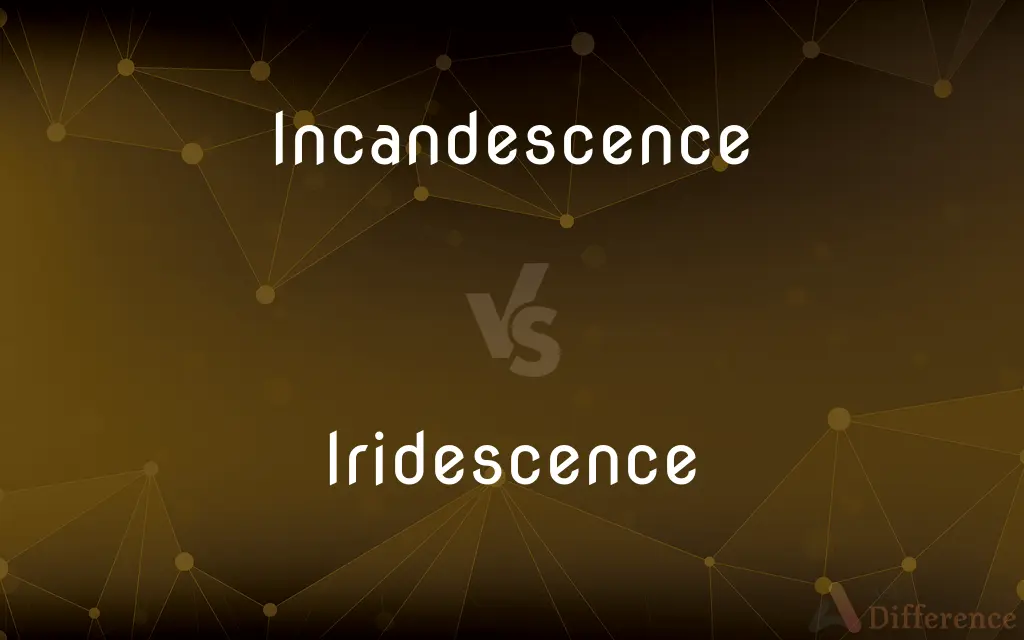Incandescence vs. Iridescence — What's the Difference?
By Tayyaba Rehman — Updated on September 27, 2023
Incandescence is light emitted by a hot object, while iridescence is a colorful phenomenon caused by light waves dispersing and reflecting off a surface or through a medium.

Difference Between Incandescence and Iridescence
Table of Contents
ADVERTISEMENT
Key Differences
Incandescence refers to the emission of light, or visible radiation, by a body, resulting from its high temperature. Objects that emit light due to high heat, like the filament in an incandescent light bulb or molten metal, exhibit incandescence. The incandescent objects radiate visible light as the atoms are excited due to the heat, and when they return to a lower energy state, they release photons. Incandescence typically produces a full spectrum of light, which results in a white glow when seen in everyday objects like light bulbs, with all colors of light being emitted.
On the other hand, Iridescence is a phenomenon where an object's surface appears to change color as the angle of view or the angle of illumination changes, often resulting in a shimmering or a gradual color change. This phenomenon occurs due to the interference, diffraction, or scattering of light, typically seen in soap bubbles, peacock feathers, and the wings of some butterflies. The observed iridescence does not result from pigmentation but from the structure of the iridescent object’s surface, altering the way light interacts with it.
Comparatively, incandescence and iridescence depict different interactions of light and matter. Incandescence is related to heat-induced light emission, producing a broad spectrum of light, whereas iridescence relates to the structural interaction of light with surfaces, leading to colorful displays dependent on observation angles. The former relies on temperature, producing a consistent glow regardless of the viewing angle, while the latter depends on the structural composition and arrangement, varying in appearance based on the perspective.
Despite their differences, both incandescence and iridescence are significant in various applications and studies. Incandescence, due to its heat relation, finds its applications in lighting and temperature measurements, offering insight into the thermal properties of materials. Iridescence, with its intricate color play, has implications in the study of optics and is a subject of interest in designing materials and coatings with specific optical properties. Both phenomena enhance our understanding of light and its interaction with different states of matter.
Comparison Chart
Cause
Emission of light due to high temperature
Dispersion, reflection, and interference of light
ADVERTISEMENT
Appearance
Consistent white glow
Changes color with angle of view or illumination
Application
Lighting, temperature measurements
Designing materials with specific optical properties
Dependence
Temperature
Structural composition and arrangement of surfaces
Representation
Represents high temperature
Represents structural interaction of light with surfaces
Compare with Definitions
Incandescence
The phenomenon where surfaces appear to change color with the angle of view.
The iridescence of the soap bubble made it look magical.
Iridescence
Iridescence (also known as goniochromism) is the phenomenon of certain surfaces that appear to gradually change color as the angle of view or the angle of illumination changes. Examples of iridescence include soap bubbles, feathers, butterfly wings and seashell nacre, as well as certain minerals.
Incandescence
A phenomenon of light causing varying colors in objects.
The iridescence in the oil spill created a spectrum of colors on the water.
Iridescence
The quality or state of being iridescent.
Incandescence
Colorful appearance due to interference and diffraction of light.
The peacock’s feathers displayed striking iridescence.
Iridescence
The condition or state of being iridescent; exhibition of colors like those of the rainbow; a prismatic play of color.
Incandescence
A change in color resulting from the specific light interaction with surfaces.
Iridescence causes the wings of some butterflies to shimmer.
Iridescence
Any shimmer of glittering and changeable colors.
Incandescence
Display of shimmering colors due to the structural composition of surfaces.
The gemstone exhibited beautiful iridescence under the light.
Iridescence
Exhibition of colors like those of the rainbow, especially a surface reflection which changes color with the angle at which the object is viewed; the quality or state of being iridescent; a prismatic play of color; as, the iridescence of mother-of-pearl. It is due to interference of light waves reflected from the front and back surfaces of a thin layer transpatrent or semitransparent film.
Incandescence
Incandescence is the emission of electromagnetic radiation (including visible light) from a hot body as a result of its high temperature. The term derives from the Latin verb incandescere, to glow white.
Iridescence
The visual property of something having a milky brightness
Incandescence
The emission of visible light by a hot object.
Incandescence
The light so emitted.
Incandescence
A high degree of emotion, intensity, or brilliance.
Incandescence
(physics) the emission of visible light by a hot body
Incandescence
The light so emitted
Incandescence
(by extension) great emotion, especially anger
Incandescence
A white heat, or the glowing or luminous whiteness of a body caused by intense heat.
Incandescence
The phenomenon of light emission by a body as its temperature is raised
Incandescence
Light from heat
Common Curiosities
Is the light emitted from Incandescence white?
Typically, incandescence produces a full spectrum of light, resulting in a white glow.
Is Incandescence a result of heat?
Yes, incandescence results from high heat causing objects to emit light.
Can Incandescence be observed in molten metal?
Yes, molten metal exhibits incandescence due to its high temperature.
What is Iridescence?
Iridescence is a phenomenon where a surface appears to change color as the angle of view or illumination changes.
Can Iridescence be seen in soap bubbles?
Yes, iridescence is commonly observed in soap bubbles, displaying a range of colors.
Are Incandescent bulbs examples of Incandescence?
Yes, incandescent bulbs emit light due to the high temperature of the filament, exemplifying incandescence.
Can Iridescence be seen in nature?
Absolutely, iridescence is observed in nature, like in peacock feathers and butterfly wings.
Can Incandescence be measured to determine temperature?
Yes, the level of incandescence can be used to measure the temperature of an object.
What causes Incandescence?
Incandescence is caused by the emission of light from an object due to its high temperature.
Is Iridescence a result of light interference?
Yes, iridescence often occurs due to interference, diffraction, or scattering of light.
Is Iridescence only due to pigment?
No, iridescence usually arises from structural variations in the object's surface, not pigment.
Does Iridescence depend on the angle of observation?
Yes, the colors seen in iridescence can change depending on the angle of view or illumination.
Does Iridescence occur in minerals?
Yes, some minerals exhibit iridescence due to their crystal structure and light interaction.
Is Incandescence dependent on the type of material?
Different materials exhibit incandescence at different temperatures, so the material type does affect incandescence.
Does Incandescence relate to the color of emitted light?
Incandescence typically results in the emission of white light, containing all colors of the spectrum.
Share Your Discovery

Previous Comparison
Stockings vs. Fishnet
Next Comparison
Seamy vs. SeedyAuthor Spotlight
Written by
Tayyaba RehmanTayyaba Rehman is a distinguished writer, currently serving as a primary contributor to askdifference.com. As a researcher in semantics and etymology, Tayyaba's passion for the complexity of languages and their distinctions has found a perfect home on the platform. Tayyaba delves into the intricacies of language, distinguishing between commonly confused words and phrases, thereby providing clarity for readers worldwide.
















































